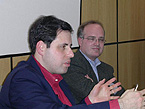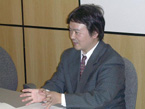Japan's Soft Power: Seminar Report
Takahiro MIYAO (Professor, GLOCOM, and Head, Japanese Institute of Global Communications)
| Seminar Summary |
| [GLOCOM Platform Monthly Seminar] |
| February Meeting: |
| Date/Time: | February 19 (Th), 16:00 - 18:00 |
| Place: | GLOCOM Hall (6-15-21-2F Roppongi, Minato-ku, Tokyo) |
| Program: |
Part 1: 16:00 – 17:00 (English)
Speaker: Ken Belson (New York Times) & Brian Bremner (Business Week)
Topic: Japan's Pop Culture-Hello Kitty
Part 2: 17:00 – 18:00 (Japanese)
Speaker: Yoshiyuki Sodekawa (Dentsu Consumer Research Center)
Topic: Japan's Soft Power Indexes
|
Part 1: Japan's Pop Culture – Hello Kitty
 In their seminar presentation, Ken Belson and Brian Bremner, who wrote a book about "Hello Kitty," took turns to explain why they got interested in Hello Kitty and how they decided to write a book about it. Specifically, Mr. Belson pointed out that there were very few books written about Hello Kitty. For a cat that makes half a billion dollars a year, that is pretty surprising because she is now one of the most well-known Japanese faces for better or for worse. So it is interesting to ask why she has become so popular, yet has so little attention paid to her. That is part of the reason why they decided to write the book. Another reason is that they, as journalists, have so far spent so much time writing about banks, card companies, economic policies – pretty serious stuff. They both wanted to look at Japan from a different perspective, say, from a street level. Hello Kitty is an interesting cross section of business practice, marketing theory, branding, global business expansion, and an interesting company – Sanrio. This is related to Japan's cool power. Now the total figure of the character goods industry in Japan is 2 trillion yen, or 16 billion dollars. But that is just a start, as this is an emerging industry and only getting bigger and growing internationally, according to Mr. Belson. In their seminar presentation, Ken Belson and Brian Bremner, who wrote a book about "Hello Kitty," took turns to explain why they got interested in Hello Kitty and how they decided to write a book about it. Specifically, Mr. Belson pointed out that there were very few books written about Hello Kitty. For a cat that makes half a billion dollars a year, that is pretty surprising because she is now one of the most well-known Japanese faces for better or for worse. So it is interesting to ask why she has become so popular, yet has so little attention paid to her. That is part of the reason why they decided to write the book. Another reason is that they, as journalists, have so far spent so much time writing about banks, card companies, economic policies – pretty serious stuff. They both wanted to look at Japan from a different perspective, say, from a street level. Hello Kitty is an interesting cross section of business practice, marketing theory, branding, global business expansion, and an interesting company – Sanrio. This is related to Japan's cool power. Now the total figure of the character goods industry in Japan is 2 trillion yen, or 16 billion dollars. But that is just a start, as this is an emerging industry and only getting bigger and growing internationally, according to Mr. Belson.
Brian Bremner emphasized Japan's "cuteness" or "kawaii," which is not only a commercial value but also is something of an esthetic value, that affects the way young girls perceive themselves and behave. They are picking up some of the cute values through TV and pop culture such as "Morning Musume", a wildly popular teen-girl pop music group. Based on this observation, Mr. Bremner focused on how "kawaii" culture and commerce could intersect and how Japanese companies in very subtle and interesting ways have taken character goods, cute little figures, to sell to represent banks, government literature, etc. Hello Kitty is the first and most interesting example of Japanese cuteness being turned into a commodity and a commercial success. When we look at Hello Kitty from those vantage points, their book is not just about the history of Sanrio and its product, Hello Kitty, but something that runs very deep--visual traits of Japanese culture and "kawaii" values. These traits and values are quite unique and deeply rooted in Japan, and they have become extremely popular among young girls with the arrival of mass consumer society.
 One question is how something so simplistic in design, a little cat with no mouth and a ribbon on one side of the head, could be so popular globally across different market groups in different countries. According to Mr. Bremner, this may be due to the fact that Hello Kitty has no defined background story, unlike Mickey Mouse or Snoopy. This is a very interesting strategy, as she is sending out different streams of meaning to different types of consumers, and becoming a mirror that reflects back anything consumers want to see. Sanrio has intentionally spent no money to advertise Hello Kitty, because a boom, if it happens, never lasts too long, and they prefer to sell this character long term in a more steady manner. As a result, Hello Kitty has become so popular in Japan and overseas that she is now regarded as a symbol of Japan, and is sometimes attacked as such, especially in Asia, according to Mr. Belson. One question is how something so simplistic in design, a little cat with no mouth and a ribbon on one side of the head, could be so popular globally across different market groups in different countries. According to Mr. Bremner, this may be due to the fact that Hello Kitty has no defined background story, unlike Mickey Mouse or Snoopy. This is a very interesting strategy, as she is sending out different streams of meaning to different types of consumers, and becoming a mirror that reflects back anything consumers want to see. Sanrio has intentionally spent no money to advertise Hello Kitty, because a boom, if it happens, never lasts too long, and they prefer to sell this character long term in a more steady manner. As a result, Hello Kitty has become so popular in Japan and overseas that she is now regarded as a symbol of Japan, and is sometimes attacked as such, especially in Asia, according to Mr. Belson.
Part 2: Japan's Soft Power Indexes
 Yoshiyuki Sodekawa talked about the soft power indexes that he developed some time ago. The word "soft power" was first used by Harvard University Professor Joseph Nye in his book "Bound to Lead" in 1989. Mr. Sodekawa's effort is to apply Nye's concept in a socio-economic context. Soft power is somewhat like brand power, which is inside the brain of the consumer and cannot be controlled by the producer. One can measure "hard power" in terms of the size of the corresponding power base such as military power, financial power, oil power, etc, but that is not necessarily the case with "soft power," which depends on those who would feel attracted to the soft power base. Therefore, it is very difficult to measure the degree of soft power. Yoshiyuki Sodekawa talked about the soft power indexes that he developed some time ago. The word "soft power" was first used by Harvard University Professor Joseph Nye in his book "Bound to Lead" in 1989. Mr. Sodekawa's effort is to apply Nye's concept in a socio-economic context. Soft power is somewhat like brand power, which is inside the brain of the consumer and cannot be controlled by the producer. One can measure "hard power" in terms of the size of the corresponding power base such as military power, financial power, oil power, etc, but that is not necessarily the case with "soft power," which depends on those who would feel attracted to the soft power base. Therefore, it is very difficult to measure the degree of soft power.
According to Mr. Sodekawa there may be two different kinds of soft power: loose soft power based on attractiveness, and tight soft power based on influence. The former is such that those who do not accept the power would only incur psychological damage, whereas the latter is associated with more substantial damage, economic or otherwise, to those who do not accept the power. In general, cultural attractiveness seems to correspond to soft power.
Mr. Sodekawa provides three axes. The first is markets and institutions, mostly economic factors, which may be characterized as "chosen power" in the global economy. The second is information, education, and intellectual power, which might be called "leadership" on global frontiers. The third is the quality of life and culture, which represents the attractiveness of a nation's culture, life style, etc. Ideally, Japanese should ask foreigners how much they are attracted to Japan's power base, but that is not feasible. So some compromises are needed and certain indexes are used to approximate soft power, which is unmeasurable.
 By using available data, Mr. Sodekawa has come up with Japan's soft power ranking among 15 major countries in the world. The result is that Japan is ranked in 6th place in terms of "total index," 11th in terms of "chosen power," 2nd in terms of "leadership," and 10th in terms of "cultural and lifestyle attractiveness." It is also pointed out that there seems to be a strong correlation between chosen power and cultural attractiveness. Finally, Mr. Sodekawa mentioned that if he were to do his study again, he would have incorporated the idea of branding, seeking the most attractive position in relation to competitors in the global "space." By using available data, Mr. Sodekawa has come up with Japan's soft power ranking among 15 major countries in the world. The result is that Japan is ranked in 6th place in terms of "total index," 11th in terms of "chosen power," 2nd in terms of "leadership," and 10th in terms of "cultural and lifestyle attractiveness." It is also pointed out that there seems to be a strong correlation between chosen power and cultural attractiveness. Finally, Mr. Sodekawa mentioned that if he were to do his study again, he would have incorporated the idea of branding, seeking the most attractive position in relation to competitors in the global "space."
|





